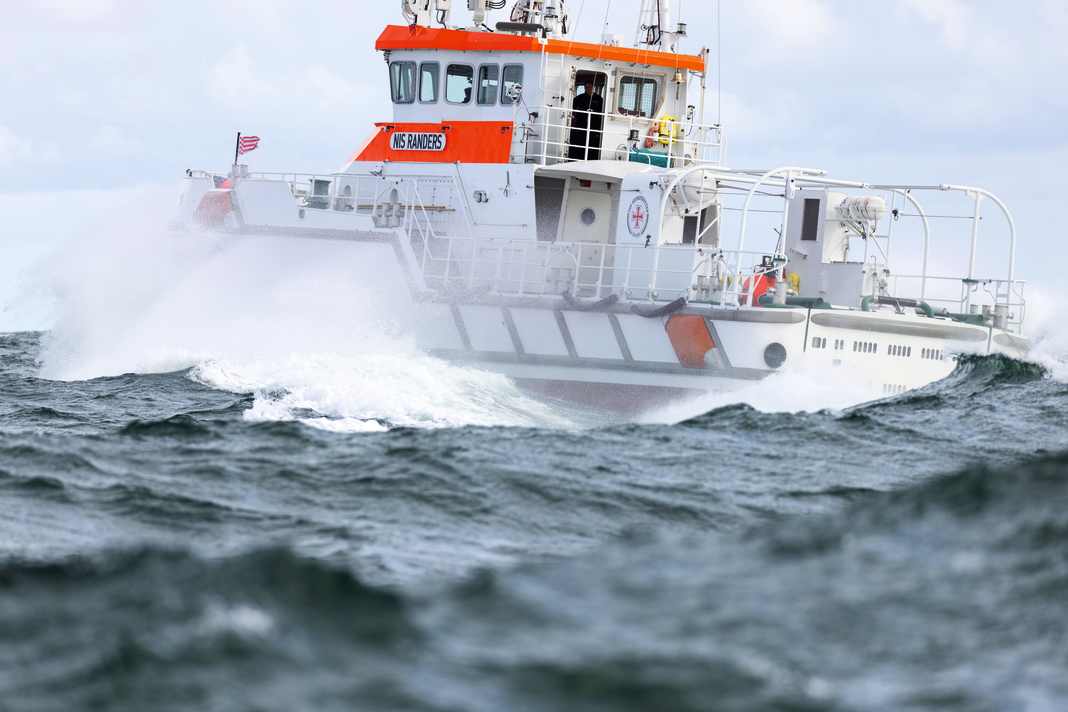





Their missions often take place far out at sea, in places that nobody can see - around the clock and in all weathers. But things are different on 11 October.
Shortly after nine o'clock, a fire breaks out on the 73-metre-long oil and chemical tanker "Annika" for reasons as yet unexplained. An environmental catastrophe is imminent because, according to the Central Command for Maritime Emergencies, the ship was carrying around 640 tonnes of oil - just a few nautical miles off the coast of Kühlungsborn, between Wismar and Rostock. Eyewitnesses report jet flames; the plumes of smoke can still be seen from Warnemünde.
Just one hour after the distress call via Channel 16, two boats from the German Maritime Search and Rescue Service have already arrived at the scene of the accident. The rescue boat "Wilma Sikorski" manoeuvres alongside in one and a half metre high waves and rescues the seven seamen from the burning tanker.
"Not an easy endeavour", as the crew later reported. They care for the men and bring them safely ashore. The second ship from the Kühlungsborn station, the "Arkona", takes part in the cooling and extinguishing work and helps to prevent anything worse from happening.
Around 2,000 DGzRS missions per year
It's missions like this that stick in the memory. Yet it is just one of around 2,000 that the more than 1,000 mostly volunteer sea rescuers in the North Sea and Baltic Sea undertake every year. Time and again, they set out from their 55 stations between Borkum in the west and Ueckermünde in the east to help people in distress at sea. In 2023, they provided assistance to 3,532 people, which is slightly more than the average. According to the DGzRS, they have rescued well over 86,000 people from distress at sea or acute danger since the organisation was founded in 1865.
Serious maritime emergencies 2024:
The most common causes of use
Whether technical support or life-saving missions - the tasks of the sea rescuers are many and varied. A look at the deployment statistics for the last three years shows which causes most frequently lead to DGzRS helpers having to be deployed.
First and foremost is the rescue of boats that have run aground. In 2023, this led to 293 operations. Groundings in the sea channels, the passages between two islands, are particularly dangerous, as the emergency of a Norwegian solo sailor this summer showed. Engine and gearbox damage is in second place. They occurred just as frequently as groundings. In 2021, there were 252 cases in this area, making it the most common. Propellers blocked by lines or nets came in third place by a wide margin. In 2021, sea rescuers assisted in 37 such cases, compared to 32 in 2023.
Other frequent reasons for call-outs are capsizing (23.3 call-outs per year on average), damage to the rudder (23), disorientation (21.3) and water ingress (19.6).
Comparison of the causes of DGzRS operations from 2021 to 2023
Interview with Christian Stipeldey

Christian Stipeldey, press spokesman for the German Maritime Search and Rescue Service (DGzRS), takes stock of the 2024 season in an interview with YACHT.
Mr Stipeldey, how did the season go for the sea rescuers?
The sea rescuers can look back on a very busy year. It will probably have been just as busy as previous years. We do not expect the number of missions to be at an extremely high level - but there are no signs of a decline either.
Can you already give specific figures?
We don't actually receive them until the new year. What's more, they are always published at an appointment with our new ambassador. This time, due to the celebrity's other appointments, that won't be until the end of January.
Is there already a discernible trend?
We are seeing more and more and ever larger ships calling at our waters. This applies to large-scale shipping, for which we are responsible, as well as to water sports. Traffic is increasing in all areas - especially in the Baltic Sea. Experts predict that the increase will continue until 2030. We are also observing this development in trend sports such as kitesurfing and paddling.
Are 2024 missions particularly memorable?
Unfortunately, we were not spared any major disasters this year either. In 2023, it was the sinking of the "Verity" in the German Bight. Almost a year later, in October 2024, we had the burning tanker "Annika" in the Baltic Sea. The volunteer sea rescuers from Kühlungsborn saved the sailors and were able to prevent an environmental disaster. That was an outstanding event, but there were challenges in all areas of shipping that year.
What was it like in the field of sailing?
Two cases can be cited as examples. At the beginning of June, a Norwegian solo sailor got into difficulties in the Seegatt between Juist and Norderney. The 46-year-old ran aground and the surf repeatedly grounded his boat. Then he went overboard and the current caught him. In the end, we rescued him.
On the other hand, I remember an eventful weekend in October. In less than 100 hours, we had 25 deployments for a total of 65 people. During this time, for example, a cargo ship collided with a sailing yacht. That was on German Unity Day. No people were injured.
What conditions lead to such an increased volume?
We observe that very little happens when storms are forecast. People prepare for it and then only those who have to are out and about. It's different when the weather changes quickly. They take many people by surprise. However, with the exception of the October weekend mentioned above, we've only had a few this year.
The island harbour of Prerow was opened in October. A sea rescue cruiser is also stationed there. Can we already draw a conclusion?
The island harbour replaces the Darßer Ort port of refuge and retains its function as a port of refuge. It was particularly important for us to stay close to the busy Kadet channel. It takes us an hour and a half to get there from our alternative berth in Barhöft, now it's only 30 minutes. However, the island harbour poses geographical challenges. Due to the coastal structure, it was foreseeable from the outset that we would not be able to occupy the harbour 365 days a year. For example, bad weather conditions occasionally make it difficult to enter and leave the harbour. In addition, the supply options at the head of the pier are limited. Once a week we have to go to Barhöft for bunkering or minor repairs. This was also the case when Darßer Ort was an emergency harbour. More details will become clear in the future.
What lies ahead for sea rescuers in 2025?
The DGzRS will be 160 years old on 29 May. Our collection boats are celebrating a real anniversary: they have been in service for 150 years.

